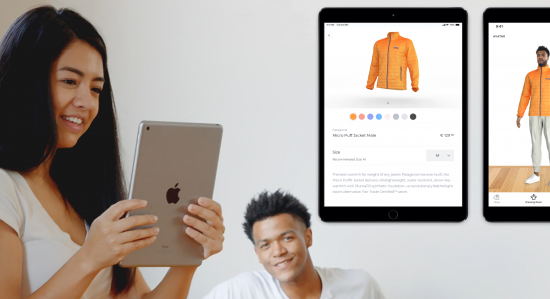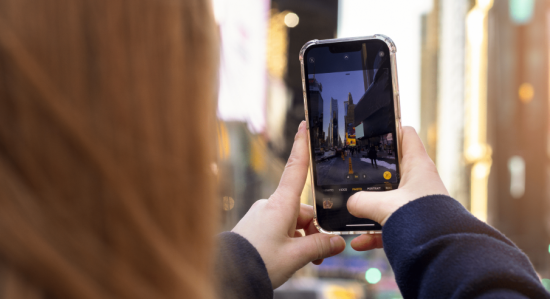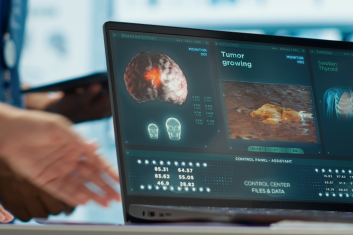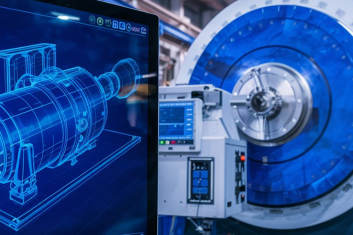Virtual Reality (VR) and Augmented Reality (AR) boost the retail industry by offering immersive shopping experiences. By donning a VR headset, consumers can explore virtual stores from anywhere in the world, interacting with products in 3D environments as if they were physically present. This technology provides retailers with innovative ways to showcase their products, while enhancing customer engagement.
AR, on the other hand, allows shoppers to visualize products in their own space through their smartphones or AR glasses, bridging the gap between digital convenience and physical retail, thus enriching the decision-making process before purchase.
Benefits of AR and VR in Retail Industry
Enhanced customer experiences
AR/VR creates immersive online shopping environments where customers can browse and purchase products in a virtual store, replicating the physical store experience from the comfort of their homes or during times when physical shopping is restricted. For instance, they can virtually step inside a furnished apartment or try on clothes without physically changing.
Increased sales and conversion rates
VR and AR technologies allow for product customization in real-time, allowing your consumers to see different colors, patterns, or configurations instantly. With immersive “try-on” visualization for products such as furniture, makeup, or clothing, they can make informed decisions, leading to higher satisfaction and lower return rates.
Boosted operational efficiency
Virtual Reality in retail can be used for training employees on product knowledge or customer service, which can result in improved sales outcomes. Better-trained staff can inspire more impulse purchases among browsing customers. AR can also assist in warehouse operations by guiding workers to pick items more efficiently or by visualizing inventory data in real-time.
Advanced data and analytics
Data collected from VR and AR interactions provides valuable insights into purchasing habits and preferred products to better tailor future marketing and inventory. So, it’s possible to generate recommendations based on customers’ purchase history – for example, by analyzing body shape and suggesting clothing styles that would flatter you most.
Applications of AR and VR in the Retail Industry
Virtual stores and showrooms
By employing digital environments, you can allow your customers to:
- explore virtual stores
- browse products and make purchases
- personalize the shopping experience with tailored recommendations
Such an approach empowers consumers to interact with products in a lifelike way and make informed purchase decisions within a convenient virtual setting.
Virtual try-ons and fitting rooms
To get a detailed understanding of the product’s features and design, consumers can use mobile applications or “AR mirrors” to:
- virtually experience products such as shoes, clothes, and accessories
- view products from multiple angles
- zoom in and out, and rotate
VR solutions allow customers to digitally sample items, gaining clear insights into fit, style, size and aesthetic placement. This lowers the risk of post-purchase regret and returns.
Customer service training
By placing employees in lifelike scenarios where they must respond appropriately, VR training can cover a wide range of skills, such as:
- conflict resolution
- troubleshooting through cause-and-effect simulations
- making recommendations and answering questions
The immersive nature of VR helps to create a more memorable learning experience, enabling employees to refine their customer service skills more effectively.
Home furnishings and decor visualization
In a realistic virtual setting, you can enable customers to see how furniture and interior objects would look in their own space. To reduce uncertainty before making a choice they can:
- explore different rooms, furniture, and decor
- experiment with various color schemes, materials, and layouts
- receive instant feedback on spatial compatibility and design suggestions
This eliminates the need for physical showrooms and in-home trials, providing a convenient way to visualize potential purchases.
AR for product information and reviews
AR virtual tags give customers instant access to rich product insights. Scanning unleashes detailed information, features and reviews for seamless discovery. This usually includes:
- overlaying digital information and images about products
- offering real-time access to product comparisons
- providing interactive 3D product demonstrations
By visually confirming product details upfront, customers can make more informed purchasing decisions from the start.
Marketing and brand awareness
By developing an Augmented Reality app for your retail business you can:
- introduce new products with immersive advertisements
- provide virtual models in stunning detail
- simulate the in-store experience from anywhere
Using this interactive marketing approach you can significantly boost brand awareness and product discovery among customers.
Why You Need a Custom AR/VR Software Solution for Retail
-
Tailored to your brand and customer experience
A custom solution allows you to seamlessly integrate your brand’s aesthetic, voice, and values into the AR/VR experience, creating a truly immersive and memorable interaction for your customers. This customized customer experience will resonate with your target audience, by offering personalized product recommendations, interactive features, and engaging content.
-
Optimized for your specific business goals
We can design AR/VR solutions to directly address your sales objectives, whether it’s increasing average order value, promoting specific products, or driving impulse purchases. Our team can create interactive experiences that encourage customers to explore your products, learn more about your brand, and share their experiences with friends and family.
-
Future-proof your retail strategy
A custom-built solution can grow with your business, allowing for updates and expansions based on technological advancements or changes in consumer behavior. We can easily adapt and scale them to changing retail environments, products, and customer needs. This scalability and flexibility ensure that your solution stays effective and relevant over time.
-
Integration with existing retail systems
We ensure a smooth and intuitive experience by integrating a custom AR/VR solution with your existing systems, such as your point-of-sale, inventory management, or customer loyalty programs. By integrating solutions with existing systems, you can unlock new revenue streams, enhance customer engagement, and gain a competitive edge in the retail markets.
Key Features of a Custom AR/VR Retail Solution
High-quality visualization
AR/VR can enable your customers to interact with and explore detailed 3D models of products from all angles, providing a more engaging and informative shopping experience. It’s possible to see products in 3D, rotate, zoom, and interact with them in a virtual environment.
Interactive design
Within the AR/VR environment you can provide instant access to detailed product information, reviews, and usage instructions by allowing customers to scan products or QR codes. You can also offer your customers interactive step-by-step guides on how to use products, increasing customer understanding.
Compatibility with multiple devices
We develop solutions that are accessible across various devices, including smartphones, tablets, AR glasses, and VR headsets, to reach a broader audience. This flexibility ensures a consistent and high-quality experience across all platforms.
Personalized shopping experience
AR/VR technologies can create tailored suggestions by leveraging customer data, ensuring that each engagement feels unique and relevant to the individual’s preferences and needs. By integrating gamified elements and interactive content, we enhance the shopping experience, making it not just engaging but also entertaining for customers.
Steps to Implementing AR and VR in Retailing

Requirement elicitation and project scoping
We define project goals and assess technical, content, and timeline needs. Our specialists work closely with clients to ensure all requirements are aligned with business objectives.MVP development or prototyping
We create basic mockups of key features for review and refinement. This iterative process allows us to gather feedback early, ensuring the final product adheres to your user expectations.Development of core functionality
We program baseline interactive and visual components. This phase focuses on building a solid foundation, ensuring that all essential features are robust and ready for further enhancement.Design and content production
We develop easy-to-use AR/VR interactions through mapping, navigation and controls. Then we create vivid 3D models, animations, and multimedia assets, and add other important features for optimal engagement.Implementation of AI algorithms for object recognition
By leveraging Machine Learning and computer vision techniques, our team trains the AI models to detect and classify objects, track movements, and understand spatial relationships, allowing for a more immersive experience.
Industries We Serve
See what our virtual and augmented reality app developers can do for your business
Education
Simulations of education labs, AR/VR tutorials, virtual trips, recreations of historical scenes.
Manufacturing
Interactive guides to help train employees, test and maintain equipment, build prototypes to evaluate new components.
Marketing
Interactive 3D models of products and holograms equipped with audio, video, buttons.
Healthcare
Safe AR/VR environments for students to learn, AR-based interfaces for medical equipment.
Real estate
Virtual guided tours around buildings with interactive 3D objects superimposed over a physical scene in real time.
Retail
Collection showcasing, virtual dressing rooms, virtual assistants, in-store navigation.
Automotive
AR/VR in the automotive industry enhances vehicle design, manufacturing, and customer experiences by enabling virtual prototyping, immersive training, and interactive car showrooms.
Sports
AR/VR-powered training programs, VR live streaming, Big Data and IoT for unique fan experiences.
Entertainment
Full-presence and immersive experiences for cinemas, TV shows, games, theaters.
Agriculture
Crop monitoring, training, and precision farming, offering immersive visualization, real-time data, and remote assistance.
Tourism
Immersive AR/VR virtual tours of destinations, landmarks, and attractions, enabling travelers to explore and plan trips remotely.
Telecom
AR and VR enhance network management with real-time data overlays for maintenance efficiency, immersive customer service, and employee training in the telecom sector.
How to Start a Virtual Reality Software Project
Easy steps to start a partnership with us
Have no specifications?
Start an elaboration stage with us.
Want a test period?
Let’s start with a pilot project of 2-4 weeks.
Confident and ready to start?
Let’s get your software project running.
FAQs
How can AR and VR enhance customer experiences in retail?
Are there any success stories or case studies of AR/VR in retail that you can share?
What are the costs associated with developing and implementing a custom AR/VR solution?
Can the AR/VR content be updated or expanded in the future?
How long does it take to develop a custom AR/VR retail solution?
We are open to seeing your business needs and determining the best solution. Complete this form, and receive a free personalized proposal from your dedicated manager.

Sergei Vardomatski
Founder






